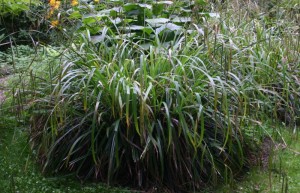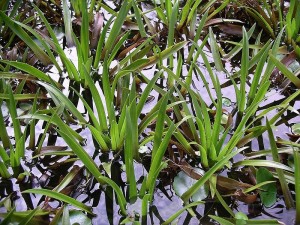






The activities of frogs, toads and newts must be taken into account when giving the pool its spring manicure. Any over-wintering vegetation should be cut back carefully, even that of so-called evergreens such as the pendulous sedge (Carex pendula). If it is allowed to remain, the new growth will be produced on and among the old winter-damaged vegetation and will always look untidy.
All marginal plants can be cut to within 5cm (2in) of the base, with the exception of any hollow-stemmed kinds that may ‘drown’ if their cut stems fill with water. The reedmaces are particularly vulnerable to this, although more so in winter than spring. This is also the time to make adjustments to planting arrangements and, where appropriate, lift and divide any plants that are overcrowded.
Plants growing in aquatic planting baskets need very regular attention. Few species that are popularly grown in the wildlife pool will remain within the confines of even a large container for more than two growing seasons. When placed close together on a marginal shelf, reeds and rushes will often travel from one basket to another. Ideally, half the total number of plants should be divided and replanted each year, which will ensure consistently good cover. If everything is lifted and divided every other season, the pool changes from spartan to crowded every two years, which makes for an unstable ecology.
Some of the more rampant scrambling plants, such as brooklime (Veronica beccabunga) and water mint (Mentha aquatica) benefit from being replaced each season. As soon as the new growth is 5cm (2in) long, remove some of the stronger shoots and root them in a tray or pot of mud. Roots will be produced rapidly, and within a couple of weeks, rooted cuttings will be available to plant back. The adult plants can then be discarded. Young plants make much more vigorous growth, yet still flower freely during the summer.
Apart from controlling plants and keeping them within bounds, there is little to be concerned about during the summer. If there are fish in the pond, sufficient open water should be retained to ensure that they can live happily and breed if they feel the urge. Often, submerged aquatics are allowed to become rampant when the pool is considered to be natural, but open water is just as important as an abundance of submerged growth for all manner of aquatic life.
Pest and disease control must not be neglected, either, for although a pool may be dedicated to wildlife, this does not mean that epidemics of aphids or mildew can be tolerated. A severe attack of waterlily aphids among succulent aquatics like the arrowhead or flowering rush, can cause such debilitation that they do not grow and flower properly, which, in turn, can affect the well-being of other insect-species, which may depend upon these plants for food or shelter.
The likelihood of severe problems is remote, but attacks can come from unexpected quarters: some insect life, which in small numbers can be fascinating and perfectly acceptable, may get out of hand. For example, large numbers of caddis fly larvae and the caterpillars of brown china mark moths can cause devastating damage, so vigilance is essential.

The removal of the bulk of fading vegetation is desirable, especially in areas where the waterlily beetle is endemic. It loves nothing better than the dying foliage of marginal plants, where it can hide for the winter. Some species may be allowed to remain if their seeds provide food for wildlife but the tidier you can make the wildlife pool for the winter, the fewer potential problems there will be in the following year.
While floating plants like the water soldier (Stratiotes aloides) and frogbit (Hydrocharis morsus-ranae) will survive quite happily outdoors, they will achieve a better start in the spring if either winter buds or small plantlets are given a little protection by being placed in a bucket of water with a layer of soil in the bottom. This should be stored in a light place. Usually, hardy floating plants fall to the bottom of the pool for the winter, taking a long time to break into growth and reappear in the spring. If you afford some protection to them in this way, their growth can be advanced and a much longer season enjoyed.
Although the wildlife pool is likely to contain native species of fish, they will still be vulnerable to the effects of being frozen in the pool. It is not the cold that kills them, but asphyxiation by the noxious gases that are produced by decomposing vegetation on the floor of the pool, which becomes trapped beneath the ice. Venting the ice cover is as important for a wildlife pool as it is for the manicured goldfish pond. Otherwise, there is little to be concerned about in winter, for all the plant species that are commonly grown in the wildlife pond are likely to be perfectly hardy.
• Cut back overwintering vegetation
• Cut back all marginal plants, except hollow-stemmed species, to within 5cm (2in) of their base
• Lift and divide overcrowded plants
• Every other year, divide half of marginal, plants growing in aquatic planting baskets
• Remove shoots of rampant scrambling plants, root them in mud and use to replace adult plants
• Cut back plants to keep them within hounds
• Cut back submerged aquatics to ensure sufficient open water for fish
• Watch for pest and disease attack
• Remove as much fading foliage from marginal plants as possible
• Collect winter buds and small plantlets of floating plants and store for the winter
• Vent pool if it freezes over by melting the ice with pans of hot water
Copyright © www.100flowers.win Botanic Garden All Rights Reserved